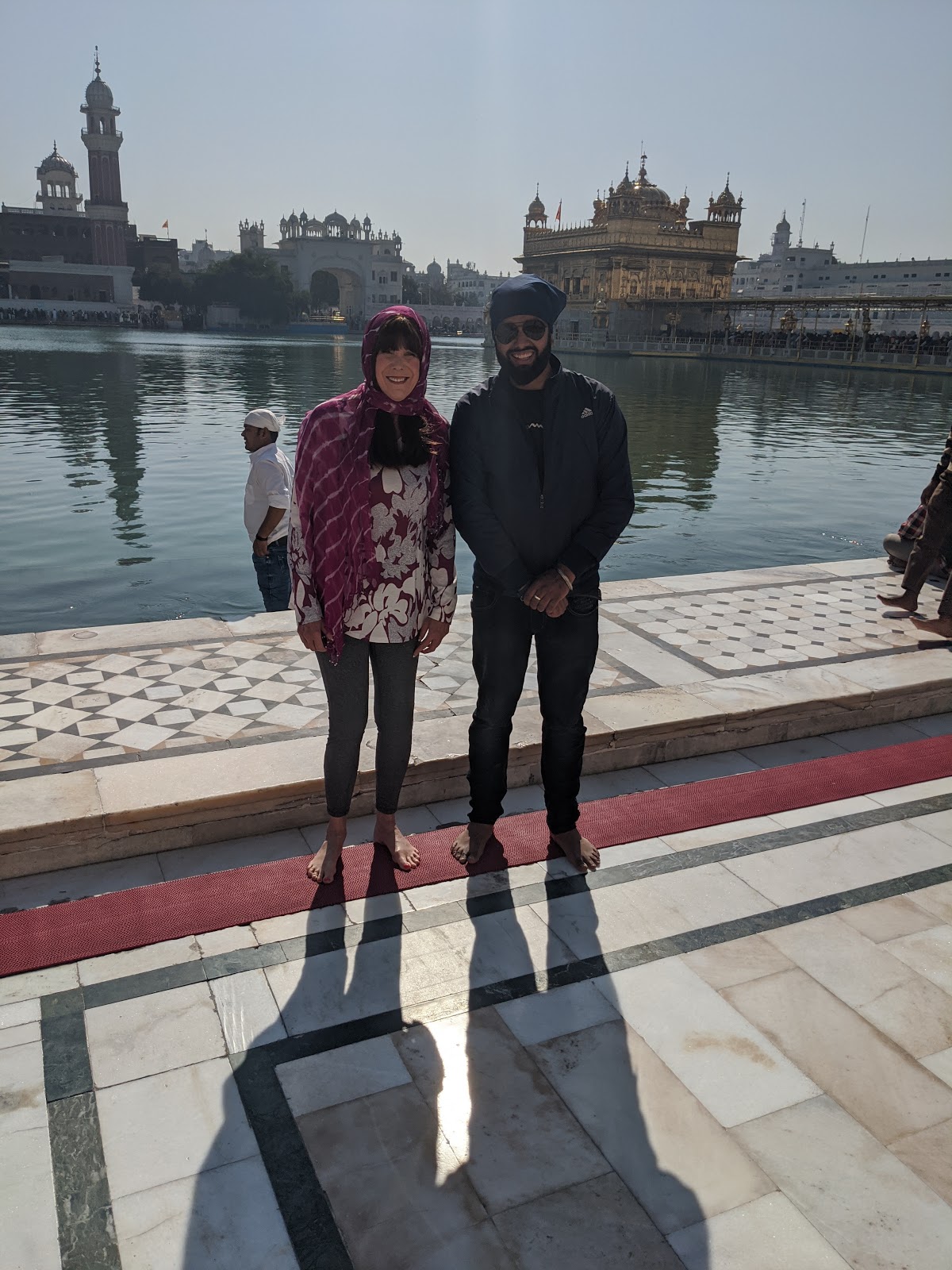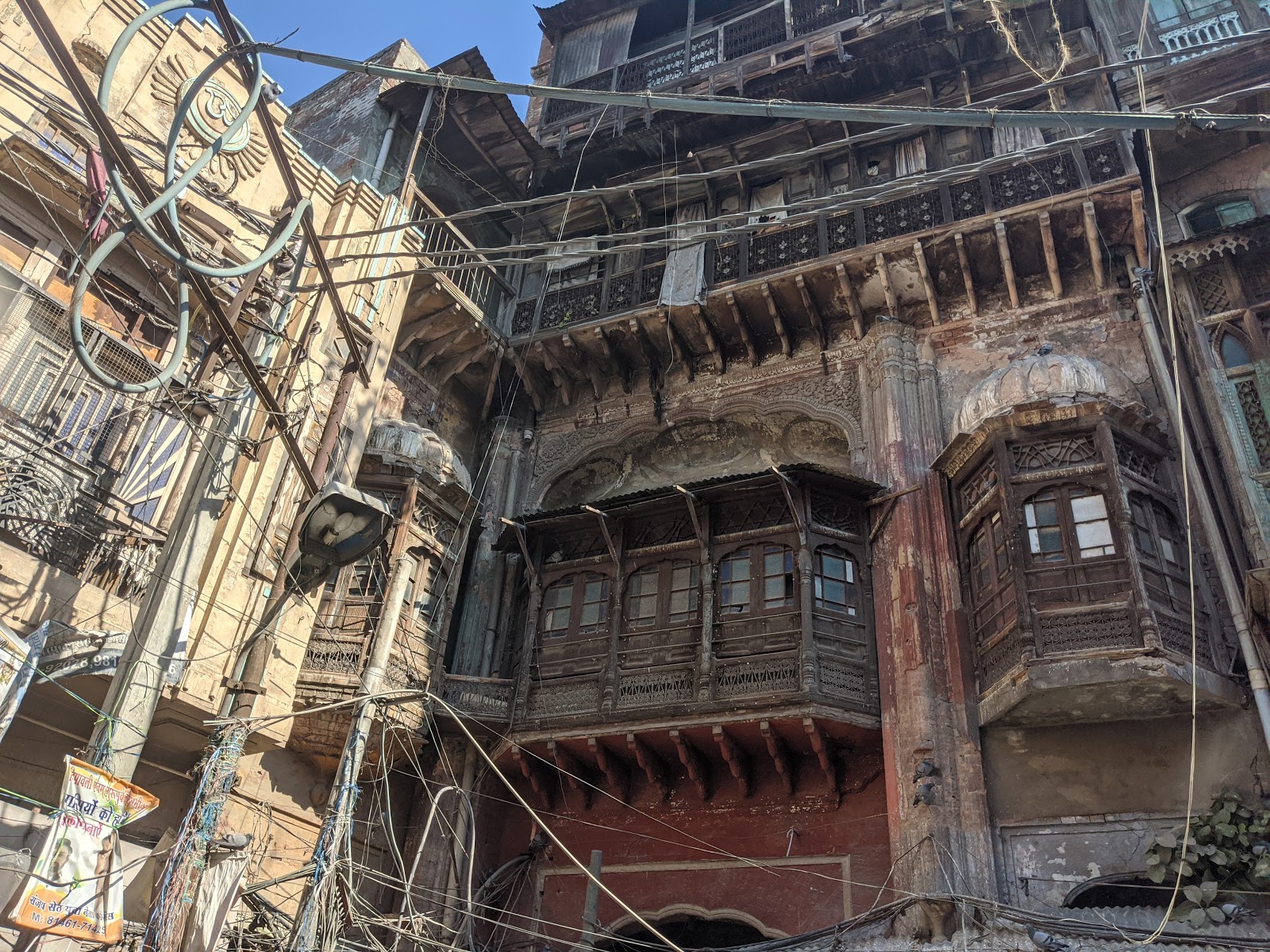 |
| The Golden Temple is seen through a decorative archway on the religious grounds of the historic Sikh location. |
Yesterday morning, our highly competent Amritsar guide Amit met us at our hotel to begin a walking tour of the historic city focusing on the world-famous Golden Temple of the Sikh people.
India’s Sikh population is approximately 24 million, only 1.72% of the country’s total population. Out of the total Sikhs in India, 77% are concentrated in Punjab, where we are now located.
 |
| We didn’t go inside the Golden Temple when the queue could easily have resulted in waiting in the line for four hours. This photo is only a tiny portion of the queue. |
 |
| Many rules surround the reading of the Holy Book, one of which includes, once the lesson begins, it cannot be stopped until completed. There is a 17-year waiting list to receive a copy of the sacred book. This and many other priests sit quietly day after day reading the sacred text written in a language few Sikhs can translate. |
There are so many aspects to this faith. We could spend years attempting to explain. However, the purpose of our posts is to share our travel and daily life experiences, leaving little time or space to elaborate. The web provides millions of entries to explain details further and answer questions curious readers may possess.
 |
| Shoes are not allowed in the temple area, and women must wear scarves, and men must wear some form of a turban. |
Below, we’ve included the history of the Golden Temple, which may appeal to those fascinated with religious history.
From this site: “Sri Harmandir Sahib, also known as Sri Darbar Sahib or Golden Temple, (on account of its scenic beauty and golden coating for English speaking world), is named after Hari (God), the temple of God. The Sikhs worldwide wish to pay a visit to Sri Amritsar and pay obeisance at Sri Harmandir Sahib in their Ardas.
 |
| Amit helped Tom fashion a turban. I thought he looked good with it! |
The land for the site was bought by the Guru Ram Das Sahib on payment from the Zamindars (landlords) of native villages.
 |
| This building is being renovated on the grounds of the Golden Temple. |
Guru Arjan Sahib got its foundation laid by a Muslim saint Hazrat Mian Mir ji of Lahore on the 1st of Magh, 1645 Bikrmi Samvat (December 1588). The construction work was directly supervised by Guru Arjan Sahib himself. He was assisted by prominent Sikh personalities like Baba Budha ji, Bhai Gurdas ji, Bhai Sahlo ji, and many other devoted Sikhs.
Unlike erecting the structure on the higher level (a tradition in Hindu Temple architecture), Guru Arjan Sahib got it built on the lower level. Unlike Hindu Temples having only one gate for the entrance and exit, Guru Sahib got it open from four sides. Thus he created a symbol of the new faith, Sikhism. Guru Sahib made it accessible to everyone without distinction of caste, creed, sex, and religion.
 |
| Two Sikh men were standing at the edge of the holy body of water. Men and women bathe separately in this man-made lake for its healing powers. |
The building work was completed in 1601 A.D. on Bhadoon Sudi 1st, 1661 Bikrmi Samvat (August/September 1604). Guru Arjan Sahib installed the newly created Guru Granth Sahib in Sri Harmandir Sahib and appointed Baba Budha ji as its first Granthi, i.e., the reader of Guru Granth Sahib. After this event, it attained the status of ‘Ath Sath Tirath.’ Now the Sikh Nation had their own Tirath, a pilgrimage center.
Sri Harmandir Sahib is built on a 67ft. square platform in the centre of the Sarovar (tank). The temple itself is 40.5ft. square. It has a door each on the East, West, North, and South. The Darshani Deori (an arch) stands at the shore end of the causeway. The door frame of the arch is about 10ft in height and 8ft 6inches in breath. The door panes are decorated with artistic style. It opens onto the causeway or bridge that leads to the main building of Sri Harmandir Sahib. It is 202 feet in length and 21 feet in width.
 |
| During the year but especially during the heat of the summer months, metal glasses are used to serve tap water to visitors. The glasses are washed by these women using a trough of ash, not water. |
The bridge is connected with the 13 feet wide ‘Pardakshna’ (circumambulatory path). It runs around the main shrine, leading to the ‘Har ki Paure’ (steps of God). On the first floor of “Har Ki Pauri,” there is continuous reading of Guru Granth Sahib.
The main structure of Sri Harmandir Sahib, functionally as well as technically, is a three-storied one. The front, which faces the bridge, is decorated with repeated cusped arches, and the roof of the first floor is at the height of 26 feet and 9 inches.
 |
| As we walked down a road toward the temple. |
At the top of the first floor, 4 feet high parapet rises on all the sides, which also has four ‘Mamtees’ on the four corners, and precisely on the top of the central hall of the main sanctuary rises the third story. It is a small square room and has three gates. A regular recitation of Guru Granth Sahib is also held there.
On the top of this room stands the low fluted ‘Gumbaz’ (dome) having lotus petal motif in relief at the base inverted lotus at the top which supports the “Kalash” having a beautiful “Chhatri” at the end.
 |
| We walked through the old part of the town of Amritsar on our return to the hotel. |
Its architecture represents a unique harmony between the Muslims and the Hindu’s way of construction work, and this is considered the best architectural specimen of the world. It is often quoted that this architecture has created an independent Sikh school of architecture in the history of art in India.”
 |
| Although not maintained, many of these old apartments are still occupied a few centuries after being built. |
 |
| We were fascinated by the historic architecture. |
 |
| Back on the busy street, we reveled in the strong cultural influences. |
